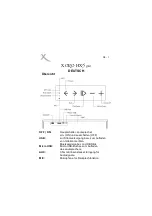On the right side of the Control Properties window, in the upper dark grey section, you will see a frequency response graph.
Underneath it are controls for 12 filters. To select a filter, click the button above its white data fields; then either type in your values, use
the up-down arrows or scroll with your mouse to adjust the parameters. At the far left is a highpass filter; its lowpass counterpart is at
the far right. These filters have three controls: Cutoff Frequency, Type (Bessel, Butterworth, etc.), and Slope. The pair of filters to the
inside are shelving filters, with controls for corner frequency and boost/cut.
The center section gives you control of 8 fully parametric filters, with controls for center frequency, boost/cut and bandwidth in octaves.
When you activate a filter, its button turns green and it appears on the graph – each filter appears in a different color. A solid line shows
the overall EQ curve. The Bypass All button at the bottom of this section lets you compare filtered and unfiltered signals quickly.
All filter parameters can be controlled with the scroll wheel on your mouse. Click inside the control field and scroll to set:
Gain, Bandwidth, Frequency, etc.
Below the EQ section in the light grey area, you’ll find controls for the Compressor on the left. The controls – Threshold, Ratio, Attack
Time, Release Time and Soft Knee – are similar to the EQ controls. You can type in values, use the Up/Down buttons, or scroll with
your mouse to find the values you want. Under Signal you will find buttons that set the compressor’s trigger point Above, At or Below
the Knee. When the compressor is operating, the Bypass button is red and the Gain Reduction meter on the right side of this section
lights up. To turn the compressor off or compare the uncompressed output, click this Bypass button.
To the right of the compression Reduction Meter is the Make-Up Gain control. This control can be used to restore RMS levels of the
compressed signal to those expected of the signal pre-compression. It has a range of 0 to +12 dB.
The RHAON input module's DSP has 340 milliseconds of signal delay available if you are using the 48 kHz sample rate; 170 millesec-
onds if you are using 96 kHz.. Use either the up-down arrows or the slider control to adjust the delay time.
User-Configurable DSP Functions
33
C
O
N
TR
O
L
M
O
D
E
Users Manual
IC-R


















